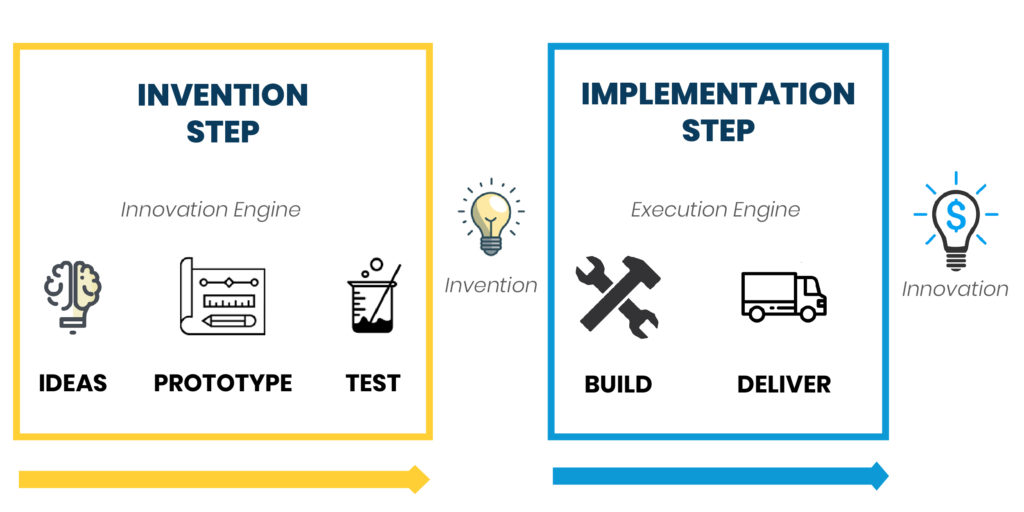Innovation is the process of taking an idea from a concept and turning it into a new or improved product, service or process that creates value for the end user. The intent of this blog post is to map out the innovation process and provide some simple practical terminology to help define innovation process.
If you want to dig a little deeper you can break innovation into two steps and five stages; the first step is “Invention” and the second step is “Implementation”. Each of the steps has a number of distinct stages as per Figure 1 below.

Figure 1 – Innovation Process
Invention
Invention is the first step in the innovation process where an idea is turned into a fully functional and tested prototype. The prototype could be a new or improved product, service or process and is built into a proof of concept design. The proof of concept prototype or invention is the input to the Implementation Step.
Idea Stage
The Idea Stage is essentially the honeymoon phase of the Innovation Process. As the name suggests in the Idea Stage is where ideas are generated, captured and managed to try and harness all of the creativity of your team, customer’s feedback and suggestions from suppliers to continuously improve existing products, services and processes as well as inspire new product ideas. Ideas from the basis of all innovation and if your organization wants to excel at innovation having a simple effective idea management system that seamlessly integrates into your other IT systems is essential. The input to the idea Stage is an idea and the output is a solution concept to be prototyped.
Prototype Stage
Prototyping your ideas into a viable solution that can be tested is the second stage in the Innovation Process. The Prototyping Stage involves research into materials, design and building of the very first product, service or process and where the concept is turned into reality. Prototype concepts are often very rudimentary proof of concept designs that would never be usable in a production environment but, are sufficient to proceed to the Testing Stage.
Testing Stage
When a viable solution has been developed into a prototype it can now be tested. The Testing Stage of the innovation process is where prototypes are evaluated for proper functioning of basic features and depending on the nature of the product may require preliminary approval or compliance testing. The input to the Testing Stage is an untested prototype and the output is a tested viable proof of concept design (invention) that can proceed to the Implementation Step.
NOTE: Proceeding to and from concept / prototyping / testing is often an iterative process where modifications are required to update or improve the product, service or process based on the testing results. A new product, service or process could potentially cycle through all the stages of the Invention Step multiple times.
Implementation
Implementation is the second step in the innovation process. In the Implementation step a functional tested prototype is developed and delivered to create market value by commercializing the invention. Invention is difficult, but Implementation is perhaps even more difficult and where most inventions fail to realize their potential. For example there were 23 light bulbs invented before Thomas Edison filed his patent for an incandescent light bulb in November of 1878 and this was his second patent not the first. History is littered with many examples of great inventions that failed to achieve market adoption.
Build Stage
In the build stage the invention developed in the first step is built into a product, service or process that is marketable to the end user. The Build Stage often involves a higher level of diligence around approvals, compliance and standards needed to bring the product, service or process to market. Development in the Build Stage also requires that the prototype be developed into a fit, form and function that can be deliver at volume.
Delivery Stage
Once the new or improved product, service or process has been built into a fit, form and function suitable for use by the end customer the producer must get the innovation to market. Delivery Stage is all of the practices, procedure and methods used to move the product from producer to end user.
Conclusion
Innovation is the process of taking an idea from a concept and turning it into a product, service or process that creates value for the end user. Hopefully you have found this article helpful in mapping out the process and providing some practical terminology that you can apply to innovation in your organization.
This article was published more than 1 year ago. Some information may no longer be current.

